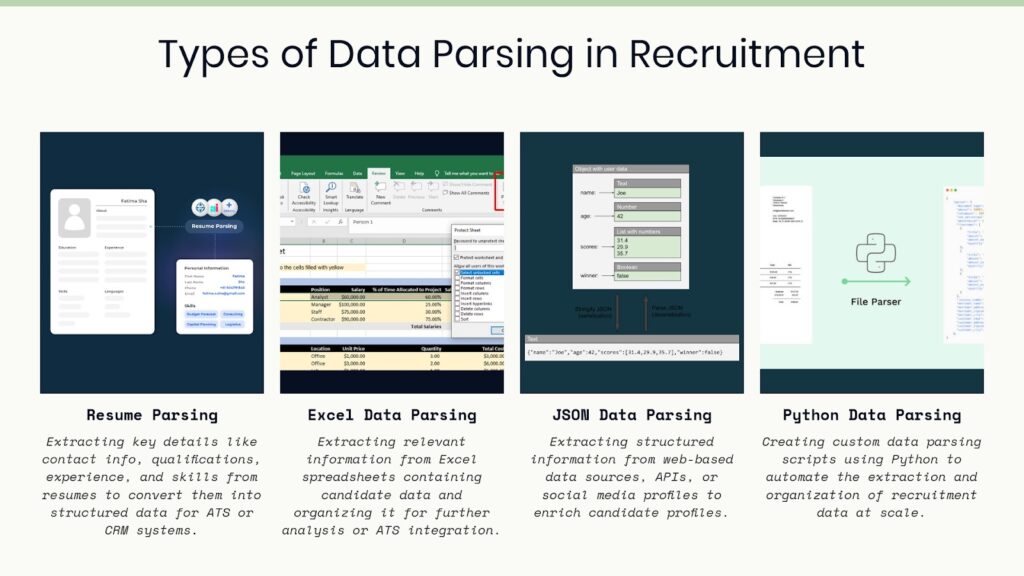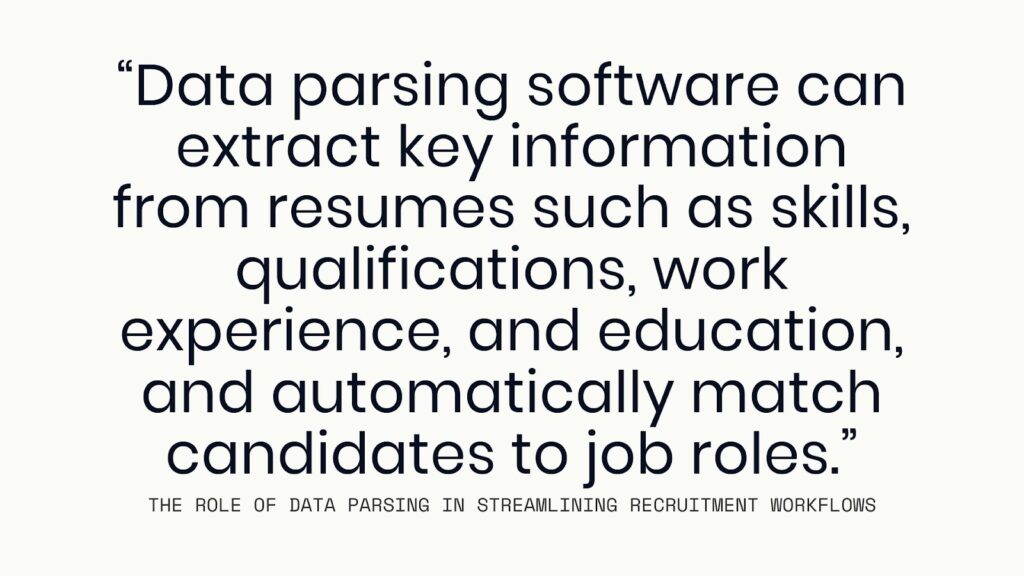During the current hiring environment, recruiters and HR professionals face an increasing demand to process large volumes of data efficiently. From resumes to job applications and candidate profiles, the volume of information can be overwhelming. However, data parsing has emerged as a crucial solution to streamline recruitment workflows, saving time and effort while improving the accuracy of the hiring process.
So, what exactly is data parsing, and how can it simplify recruitment? In this article, we’ll discuss how data parsing plays a pivotal role in optimizing recruitment workflows. We’ll also explore how data parsing software can enhance hiring efficiency, how data parsing tools work, and the ways recruiters can implement them to stay ahead in a competitive market.
What is Data Parsing?
Data parsing refers to the process of converting structured or unstructured data into a format that is easily understandable and usable by computer systems. Essentially, it breaks down complex data into smaller components so that it can be processed automatically, making the data more readable and organized.
In the context of recruitment, data parsing can help extract valuable information from resumes, cover letters, and job applications. This eliminates the need for manual data entry and allows recruiters to focus on more strategic aspects of hiring, such as candidate engagement and interviewing.
Imagine trying to manually sift through hundreds or even thousands of resumes. Without the ability to automatically parse that data, this would be time-consuming, error-prone, and inefficient. That’s where data parsing software comes into play.
How Data Parsing Simplifies Recruitment Workflows?
Recruitment involves various stages such as screening resumes, shortlisting candidates, and scheduling interviews. Each of these stages requires dealing with large amounts of data, whether it’s candidate information, job descriptions, or interview schedules. Here’s how data parsing can streamline these steps:
1. Resume Screening and Candidate Shortlisting
One of the most time-consuming parts of recruitment is screening resumes. Recruiters spend hours reading through applications to find candidates who match the job requirements. However, data parsing software can extract key information from resumes such as skills, qualifications, work experience, and education. This parsed data can then be used to automatically match candidates to job roles, reducing the workload for recruiters.
For instance, using data parsing tools, a recruiter can quickly scan through hundreds of resumes in minutes, identifying candidates with the required skills. This not only saves time but also improves the accuracy of the screening process. The software is also adept at parsing data in Excel, allowing the parsed information to be organized in spreadsheets for easy access and analysis.
2. Automating Data Entry
Manually entering candidate data into applicant tracking systems (ATS) can lead to errors and inconsistencies. Data parsing software automates this process by extracting data from resumes and applications and feeding it directly into the system. This eliminates human error and ensures that data is consistently organized across all stages of the recruitment process.
For example, when a candidate submits a resume, the data parsing tool can automatically extract their name, contact details, and relevant skills, and input this data into the ATS. The recruiter can then access a clean, organized profile without spending time manually entering the information.
3. Better Candidate Matching
Once data is parsed, it becomes easier to match candidates to open positions. Instead of manually comparing candidate profiles with job descriptions, data parsing software can automatically find the best matches based on the parsed information. This ensures that recruiters can quickly identify candidates who are the best fit for the role, reducing the time it takes to make hiring decisions.
In addition, by parsing JSON data from candidate profiles on job boards, recruiters can gather structured information and perform advanced searches based on specific criteria, such as technical skills or industry experience. This makes the hiring process faster and more efficient.
4. Managing Large Volumes of Data
As recruitment processes scale, HR teams often have to manage a large volume of data. This includes not only candidate resumes but also job postings, internal reports, and communication logs. Data parsing helps manage this data more efficiently by extracting the relevant information and organizing it into easily searchable formats.
For example, data parsing in Python can be used to create automated scripts that extract data from multiple sources, such as emails or web forms. These scripts can then structure the data in a way that is easier to analyze, making it possible for recruitment teams to track trends and improve decision-making processes.
What are different Types of Data Parsing in Recruitment?
Recruiters often deal with various types of data, each requiring different parsing approaches. Here are the most common data formats parsed in recruitment workflows:

1. Resume Parsing
Resume parsing is the most widely used form of data parsing in recruitment. It involves extracting key details such as contact information, qualifications, experience, and skills from resumes, converting them into structured data that can be processed by an ATS or CRM system.
2. Parsing Data in Excel
In some cases, recruiters may receive candidate information in Excel files. Parsing data in Excel allows the extraction of relevant information from these spreadsheets and organizes it in a way that can be further analyzed or imported into ATS systems. This is especially helpful when dealing with large datasets.
3. Parsing JSON Data
For recruiters working with web-based data or APIs, parsing JSON data allows for the extraction of structured information from job portals, social media profiles, or third-party databases. This data can be used to enrich candidate profiles or gather additional information about potential hires.
4. Data Parsing with Python
Python is a popular programming language for creating custom data parsing tools. By leveraging data parsing in Python, HR tech teams can create automated solutions tailored to their recruitment needs. This is especially useful for companies looking to build scalable recruitment systems that can process large volumes of data with minimal human intervention.
How Data Parsing Software Enhance Recruitment Efficiency?
Now that we understand how data parsing simplifies recruitment workflows, let’s explore how data parsing software plays a crucial role in this process. Modern recruitment platforms come equipped with advanced parsing capabilities, allowing them to handle everything from resume parsing to application processing and candidate matching.
1. Improved Speed and Accuracy
Data parsing software speeds up the hiring process by automating data extraction and entry. This reduces the time spent on manual tasks, allowing recruiters to focus on high-value activities. Additionally, the accuracy of parsed data means that recruiters can make more informed decisions based on reliable information.
2. Enhanced Data Security
Recruitment involves handling sensitive candidate information, including personal and financial data. Data parsing tools ensure that this data is securely stored and processed in compliance with data protection regulations. By automating the data management process, these tools reduce the risk of human error, ensuring that sensitive information is kept confidential.
3. Better Integration with ATS and HR Systems
Most data parsing software integrates seamlessly with existing Applicant Tracking Systems (ATS) and HR platforms. This integration ensures that parsed data is automatically transferred to the right systems, reducing the need for manual data input and ensuring that recruiters have access to updated, real-time information.
4. Scalability for Growing Businesses
For companies that are scaling their recruitment efforts, data parsing offers the flexibility to handle larger volumes of data without overwhelming recruitment teams. Whether you’re dealing with an influx of job applicants or managing a high number of job openings, data parsing tools can keep up with the demands of a growing business.

Conclusion
In a competitive job market, recruiters and HR professionals need every advantage to streamline their workflows and stay ahead. Data parsing offers a powerful solution to simplify the recruitment process, from resume screening and data entry to candidate matching and hiring decisions. By leveraging data parsing software, HR teams can automate tedious tasks, reduce errors, and make more informed hiring decisions, ultimately improving the efficiency of the recruitment workflow.
Whether it’s parsing data in Excel or parsing JSON data from candidate profiles, data parsing allows recruiters to turn overwhelming amounts of information into actionable insights. For HR tech companies looking to provide cutting-edge recruitment solutions, integrating robust data parsing tools is a must.
By embracing the potential of data parsing, recruitment teams can not only streamline their workflows but also make the hiring process faster, more accurate, and more efficient, ensuring that they find the right talent at the right time. Incorporating data parsing into your recruitment process can revolutionize the way you hire. Sign up with JobsPikr to leverage data-driven recruitment insights and streamline your hiring workflow.



